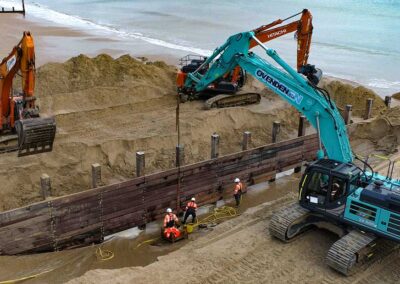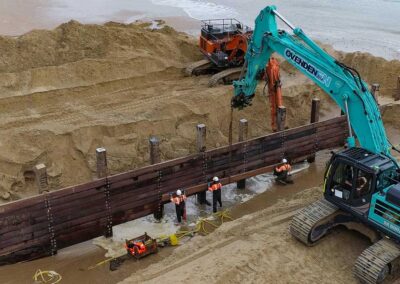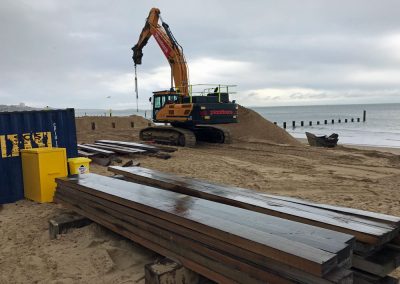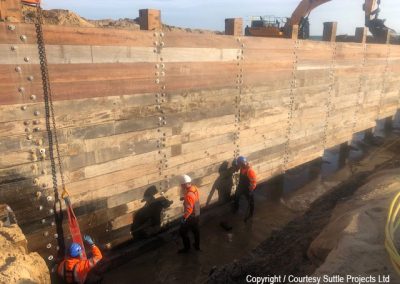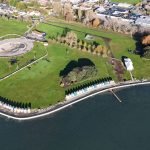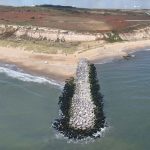Completed Projects
Timber Groyne renewal programme, winter 2021/22
Year 2 of a two-year, £1.84 million programme to renew eight timber groynes from the boundary of Poole/Bournemouth to West Cliff zig-zag
LEAD AUTHORITY
BCP Council
WORKING WITH
START DATE
4th October 2021
END DATE
1st February 2022
Groyne works complete, Durley Chine beach fully open
Durley Chine beach has been fully reopened following the successful renewal of life-expired timber groynes between Middle Chine and West Cliff zig-zag. Works were completed two months ahead of schedule, and within budget, thanks to operating efficiencies, good weather and tides.
Next winter the timber groyne renewal programme continues at Bournemouth Pier.
Some of the old groyne timber which couldn’t be recycled into the new groynes has been used to clad parts of the Environmental Innovation Hub at Durley Chine (indicated on the working area diagram above). For Hub project details please visit bcpseafrontprojects.net/durley-chine.
Project Overview
The work carried out this winter was the second year of a 2-year programme covering the frontage from the Poole/Bournemouth boundary to West Cliff, with three old groynes replaced by four new more evenly spaced groynes between Middle Chine and West Cliff zig-zag path.
Our contractors Suttle Projects Ltd, arrived on site on 4th October 2021. Operating Monday to Saturday, from 7am to 7pm, they worked on multiple groynes simultaneously and flexibly with the lowest tides on a rota system. The project was originally expected to be completed in the spring.
On site November & December
Works progressed well thanks to operating efficiences and good weather.
Site signage
Deconstructing and reconstructing a timber groyne – how it’s done
The planking of a new groyne begins from the top down
The planking of a new groyne begins from the top down
Timber used for the new groynes
Each new groyne will be constructed using a mix of new tropical hardwood timber and recycled tropical hardwood planking, from previously deconstructed timber groynes, when available.
Hardwoods used will be Greenheart – a pale yellow to dark olive green wood from Guyana, South America, and Ekki – a dark red / deep chocolate-brown wood from West Africa and the Congo. These timbers have been selected for their strength, durability and resistance to marine life which can destroy wood by boring into and eating it.
FUNKY FACTS ABOUT POOLE BAY GROYNES
A total of 29 piles are sunk for a timber groyne, each pile is 10m long and spaced 2.5m apart. The King pile (out at sea) is 12.5m long. Piles are driven down to the first solid layer of stable substrate/clay. Each groyne is between 5m-7.5m deep and roughly 75m in length. Approximately 225 planks of timber make up a groyne. Generally only the top 5 rows are constructed using new timber; recycled timber is used for the bottom 12-14 rows. Timbers unsuitable for re-use on new groynes are recycled for other projects; for example in 2022, for cladding and decking at the Environmental Hub at Durley Chine, and as part of a footbridge created at a flooded wetland scheme in the Tamar Valley AONB, Cornwall.
Information on projects that reuse BCP groyne timber can be found at our Recycling & Reusing page.
Visitor access & safety
Access along the promenade, and to beach huts, will be maintained to enable you to pass the works, but areas of the beach are restricted for safety reasons. The sand becomes very unstable when it is excavated around groynes. For this reason, please do not enter or pass the construction zone along the water’s edge, even at low tide. Dogs should be kept on a lead.
Once work is finished, restrictions will remain in place until the sand dries out and becomes more compact and stable underfoot.
Environmental considerations
All the groyne renewal works will be carried out in accordance with the Marine Management Organisation licence and planning consent. Additionally, new tropical hardwood timber used for this project is certified sustainable by the Forestry Stewardship Council (FSC).
The old groynes will be carefully deconstructed to ensure that all suitable materials can be recovered and recycled or re-used in future coastal projects.
Groynes – their role in coast protection
Beach material generally moves from west to east in Poole Bay. The strategically placed groynes are renewed approximately once every 25 years and slow down the natural processes. Piling and planking deep into the beach to the first solid layer of substrate/clay helps retain the sand within the groyne field.
In combination with periodic beach renourishment (topping-up the beach levels) the groynes also help protect the seawalls and cliffs from erosion. We last renourished some of the beaches from Poole to Southbourne in early 2021 [details here].
Previous phases of timber groyne renewal:
- Winter 2020/21 – Year 1 of a two-year renewal project, 4 groynes eastwards from Poole/Bournemouth boundary to Middle Chine
- Winter 2017/18 and 2018/19 – 12 groynes at Southbourne
- Winter 2016/17 – 8 groynes eastwards from Fisherman’s Walk to Gordon’s Corner
- Winter 2015/16 – 10 groynes from the east of Boscombe Pier to Fisherman’s Walk


